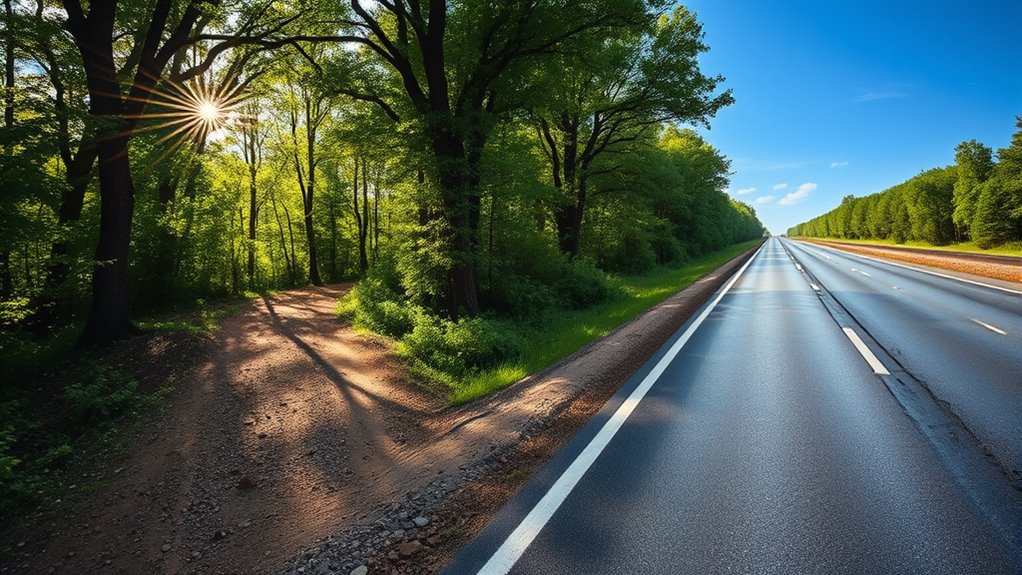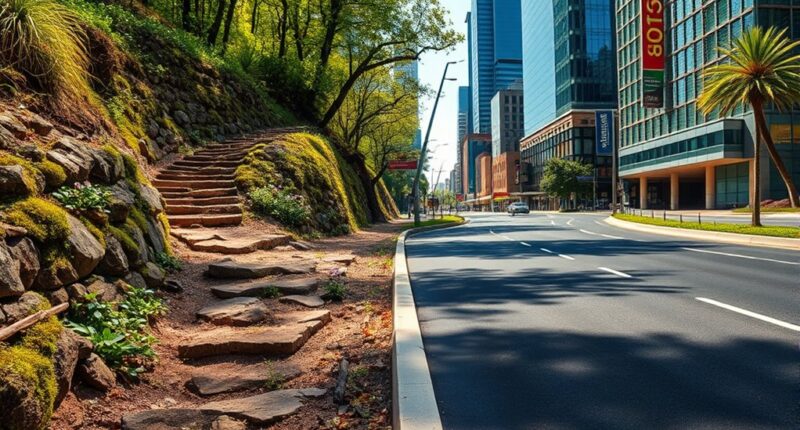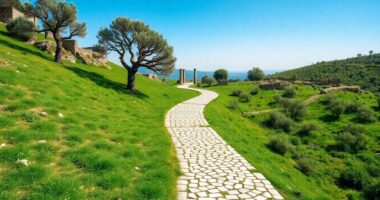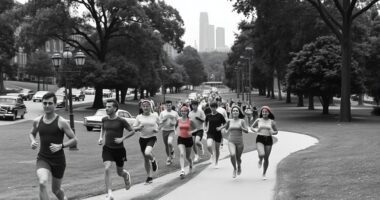Road and trail riding each tell a unique cultural story. Roads symbolize progress, urban growth, and modern life, shaping how communities connect and evolve. Trails represent a deep bond with nature, emphasizing sustainability, outdoor adventure, and ecological respect. Your choices reflect broader values about development and conservation. Exploring their history reveals how societies balance progress with environmental care—keep going to uncover more about this fascinating cultural relationship.
Key Takeaways
- Road riding symbolizes urban progress, connectivity, and modern lifestyles, reflecting societal values of speed and efficiency.
- Trail riding emphasizes harmony with nature, outdoor adventure, and ecological preservation, highlighting environmental awareness.
- Historically, roads facilitated trade and urban development, while trails represented indigenous routes and natural pathways.
- Cultural perceptions associate roads with progress and modernization, whereas trails evoke tradition, conservation, and outdoor skills.
- The shift towards sustainable transportation influences the cultural narrative, balancing urban growth with ecological responsibility.

When deciding between road and trail riding, understanding the key differences can help you choose the best option for your style and goals. Road riding typically takes place on paved surfaces within urban environments, where development has carved out networks of streets and highways over time. This form of riding is deeply intertwined with the growth of cities and towns, reflecting a culture that values speed, connectivity, and accessibility. As urban development expanded, roads became essential arteries for transportation, shaping daily routines and social interactions. However, this expansion also brought notable environmental impacts, such as habitat fragmentation, pollution, and increased runoff, which have altered local ecosystems. When you ride on roads, you’re often steering through spaces that have been heavily modified by human activity, which can contribute to a sense of progress but also raises concerns about sustainability. The development of road networks has historically driven economic growth and urbanization, but it has also contributed to environmental challenges like increased greenhouse gas emissions.
Road riding on paved urban streets reflects progress but raises environmental sustainability concerns.
Trail riding, on the other hand, often takes you away from the hustle and bustle of urban centers into natural landscapes. Trails are usually found in parks, forests, or rural areas, emphasizing preservation and harmony with the environment. This form of riding celebrates outdoor adventure and a connection to nature, often rooted in a culture that values conservation and outdoor recreation. Unlike the built environments of urban roads, trails tend to follow the natural contours of the land, minimizing the environmental impact when maintained responsibly. However, even trail riding can have effects on local ecosystems—such as soil erosion, disturbance to wildlife, and vegetation damage—especially if riders neglect sustainable practices. Nonetheless, trail riding encourages a different relationship with the environment compared to city-based road riding, fostering appreciation for untouched landscapes and promoting conservation efforts. Understanding the environmental impact of trail riding can help promote more sustainable practices among enthusiasts.
Culturally, both forms of riding reflect broader societal values. Road riding is often associated with mobility, efficiency, and the modern lifestyle, highlighting how urban development has shaped our transportation habits. It’s also a symbol of progress and connectivity, enabling people to traverse vast distances quickly. Conversely, trail riding embodies a more ecological and contemplative approach, emphasizing harmony with nature, outdoor skills, and preservation. The history of these riding styles reveals how human activity influences the environment and vice versa. While roads have facilitated urban growth and economic development, they’ve also caused environmental degradation. Trails, meanwhile, represent a more sustainable, if sometimes controversial, interaction with the land.
In choosing between road and trail riding, you’re not just selecting a mode of transportation or recreation—you’re engaging with a cultural history that echoes our relationship with the environment and our communities. Recognizing the environmental impact of each can help you make more mindful choices, whether that means supporting sustainable trail practices or advocating for smarter urban planning that minimizes ecological harm.
Frequently Asked Questions
How Have Roads and Trails Influenced Indigenous Cultures Historically?
You see, indigenous pathways shaped cultures by connecting communities and fostering trade, communication, and spiritual practices. These trails hold deep cultural significance, serving as sacred routes for ceremonies and migrations. They influence your understanding of history, showing how movement and connection preserve traditions and identity. Roads and trails aren’t just routes—they’re essential to indigenous cultures, symbolizing unity, resilience, and the enduring importance of land and community.
What Role Do Roads and Trails Play in Modern Urban Development?
You see, roads and trails are essential to modern urban development because they shape transportation infrastructure and influence urban planning. They connect neighborhoods, facilitate commerce, and improve accessibility, making cities more livable. When you consider new projects, you realize that well-designed roads reduce congestion and promote sustainable growth. They also support economic vitality by enabling efficient movement of people and goods, ultimately shaping the city’s future.
How Did the Invention of the Automobile Impact Trail Preservation?
The automobile proliferation swept through the landscape like a tidal wave, pushing trails aside in the rush for faster travel. You see, this shift led to a decline in trail conservation efforts, as roads took priority for urban and suburban expansion. The impact was significant—fewer natural routes remained preserved, and many trails suffered neglect or destruction. You can still fight to protect these historic paths, ensuring they’re not lost to modern development.
Are There Any Significant Legal Differences Between Road and Trail Use?
You’ll find significant legal differences between road and trail use. Roads are typically governed by property rights and access regulations set by government authorities, allowing public or private control. Trails, however, often have stricter access rules, especially on private land, and may require permits or permissions. These legal distinctions influence how you can use and maintain these paths, impacting conservation efforts and access rights.
How Do Climate Change and Environmental Concerns Affect Road and Trail Maintenance?
Climate change and environmental concerns push you to prioritize sustainable infrastructure for roads and trails. You need to contemplate ecological impacts, such as erosion, habitat disruption, and increased maintenance costs from extreme weather. By implementing eco-friendly materials and designs, you can reduce environmental harm, improve resilience, and guarantee long-term usability. This approach helps protect natural resources while maintaining accessible, sustainable pathways for future generations.
Conclusion
As you reflect on the road and trail, remember they’re like two sides of the same coin—each shaping our journey in unique ways. The road offers structure and progress, while the trail invites adventure and discovery. Embrace both, and your path becomes richer, like a tapestry woven with different threads. Whether you prefer the certainty of the road or the wild spirit of the trail, your journey is yours to create—so go ahead, explore with open eyes and an enthusiastic heart.









